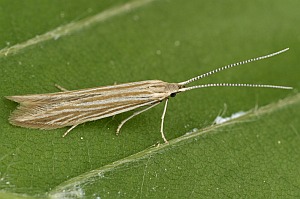

 +28Kontinente:EUAS
+28Kontinente:EUAS1. Lebendfotos
1.1. Falter
1.2. Raupe, Raupensack
1.3. Fraßspuren und Befallsbild
2. Diagnose
2.1. Männchen
2.2. Genitalien
2.2.1. Männchen
2.2.2. Weibchen
2.3. Erstbeschreibung
Im Folgejahr hierzu erschienene Abbildung
3. Biologie
3.1. Nahrung der Raupe
- [Asteraceae:] Artemisia vulgaris (Gewöhnlicher Beifuß)
- [Asteraceae:] Artemisia absinthium (Wermut)
- [Asteraceae:] Tanacetum vulgare [= Chrysanthemum vulgare] (Rainfarn)
- [Asteraceae:] Tanacetum corymbosum [= Chrysanthemum corymbosum] (Straußblütige Wucherblume, Straußblütige Margerite)
- [Asteraceae:] Achillea millefolium (Wiesen-Schafgarbe, Gewöhnliche Schafgarbe)
- [Asteraceae:] Achillea erba-rotta ssp. moschata [= Achillea moschata] (Moschus-Schafgarbe)
- [Asteraceae:] Leucanthemum vulgare (Gewöhnliche Margerite)
- [Asteraceae:] Bellidiastrum sp. ??
- [Asteraceae:] Carduus sp. ?? (Distel ??)
- [Asteraceae:] Hieracium spp. ?? (Habichtskraut ??)
- [Asteraceae:] Inula spp. ?? (Alant ??)
- [Asteraceae:] Eupatorium cannabinum ??? (Wasserdost ???)
- [Asteraceae:] Anthemis sp. ???
Baldizzone (2019: 497) listet auf: "Piante nutrici appartenenti alla famiglia Asteraceae: Achillea millefolium, A. moschata, Anthemis spp., Artemisia vulgaris, A. absinthium, Bellidiastrum spp., Carduus spp., Hieracium spp., Inula spp., Leucanthemum vulgare, Tanacetum corymbosum, T. vulgare."
[Bladmineerders.nl (abgefragt 14. Juli 2022)] schreibt ganz ähnlich, allerdings mit eingebauter Warnung: "Asteraceae, narrowly oligophagous - Achillea millefolium; Artemisia absinthium, vulgaris; Carduus; Inula; Leucanthemum vulgare; Tanacetum corymbosum, vulgare. Because in the past the interpretation of this species has long been uncertain, references of food plants from that time are unreliable. References to Hieracium need confirmation."
Artemisia vulgaris, Artemisia absinthium und Tanacetum vulgare sind unter anderem durch oben gezeigte Bilder gut abgesichert.
Emmet et al. (1996: 294) berichten aus Großbritannien: "Confirmed foodplants in Britain are mugwort (Artemisia vulgaris), wormwood (A. absinthium), yarrow (Achillea millefolium), tansy (Tanacetum vulgare) and ox-eye daisy (Leucanthemum vulgare) (Langmaid, 1991b)." Und dann folgt: "Uffen gives hemp-agrimony (Eupatorium cannabinum also, possibly through confusion with C. follicularis. Razowski (1990) adds Inula, Carduus and Hieracium. C. trochilella sensu Hering (1957) appears to be C. peribenanderi Toll, and the foodplants he lists are therefore omitted. More research is needed into the range of foodplants."
(Autor: Erwin Rennwald)
4. Weitere Informationen
4.1. Andere Kombinationen
- Ornix trochilella Duponchel, [1843] [Originalkombination]
- Casignetella trochilella (Duponchel, 1843) [so bei Anikin et al. (2017) und Sinev (2019)]
4.2. Synonyme
- Coleophora lineatella Tengström, 1848
- Coleophora alpicola Heinemann & Wocke, 1876 [synonymisiert von Baldizzone (1989: 149)]
- Coleophora corymbosiella Bauer, 1917 [synonymisiert von Baldizzone (1985: 196)]
- Coleophora axana Hering, 1942 [synonymisiert von Baldizzone (1985: 196)]
4.3. Publikationsjahr der Erstbeschreibung
Woodward (1922: 380) [Digitalisat auf biodiversitylibrary.org] teilt die Publikationsjahre des Bandes mit: 1-112 (mit ?) und pl. 51-56 1842, 113-480 (mit ?) und pl. 57-72 1843, 481-[555] (mit ?) und pl. 73-80 1844, pl. 81-90 1845.
(Autor: Jürgen Rodeland)
4.4. Literatur
- Anikin, V.V., Sachkov, S.A. & V.V. Zolotuhin (2017): "Fauna lepidopterologica Volgo-Uralensis": from P. Pallas to present days. — Proceedings of the Museum Witt Munich, Volume 7: 1-696; Munich and Vilnius.
- Baldizzone, G. (1985): Nueve sinonimie nel genere « Coleophora » Hubner (IV). Contribuzioni alla conoscenza dei « Coleophoridae ». XL (Lepidoptera). — Rivista Piemontese di Storia Naturale 6: 181-198. [PDF auf storianaturale.org]
- Baldizzone, G. (1989): Contribuzioni alla conoscenza dei Coleophoridae. LVIII. Nuove sinonimie nel genere Coleophora Hübner (VII) (Lepidoptera). — Rivista Piemontese di Storia Naturale 10: 145-154. [PDF auf storianaturale.org]
- Baldizzone, G. (2019): Fauna d’Italia. Vol. LIII. Lepidoptera Coleophoridae. - XVII + 907 S.; Milano (Calderini).
- Erstbeschreibung: Duponchel, P.-A.-J. (1842-[1845]): Histoire naturelle des lépidoptères ou papillons de France. Supplément aux tomes quatrième et suivants: 1-554, [555], pl. LI-XC. Paris (Méquignon-Marvis).
- Emmet, A.M., Langmaid, J.R., Bland, K.P., Corley, M.F.V. & J. Razowski (1996): Coleophoridae. - S. 126-338. In: Emmet, A.M. [Hrsg.](1996): The moths and butterflies of Great Britain and Ireland. Volume 3. Yponomeutidae - Elachistidae. - 452 S.; Colchester, Essex.
- Синёв, С. Ю. [ed.] (2019): Катапог чешуекрылых (Lepidoptera) России. Издание второе [Sinev, S. Yu. (ed.) (2019): Catalogue of the Lepidoptera of Russia. Second edition]: 1-448.
- Woodward, B. B. (1922): Catalogue of the Books, Manuscripts, Maps and Drawings in the British Museum (Natural History). Vol. VI. Supplement: A–I: i-iv, 1-511, 1-48. London.






























































